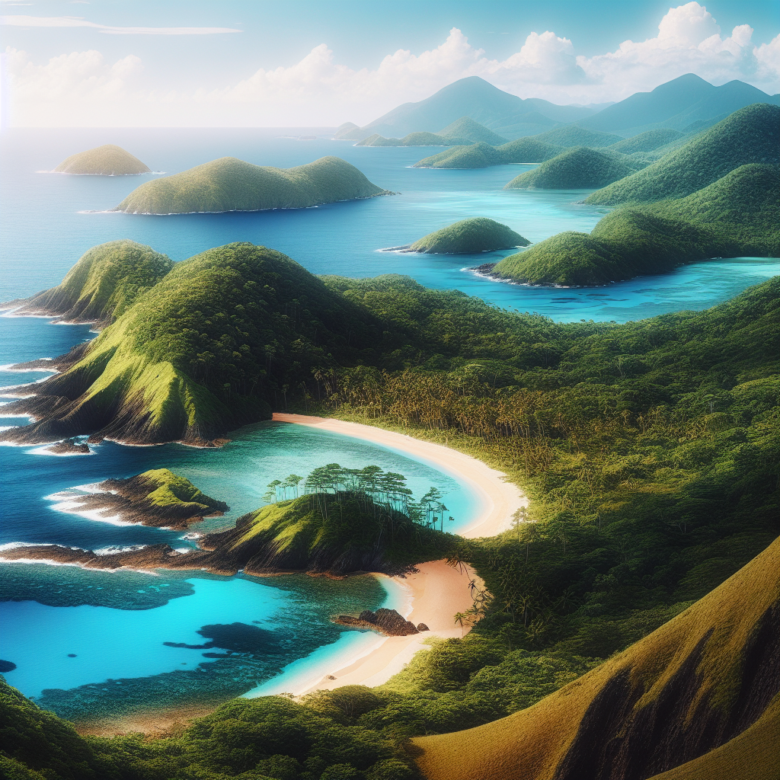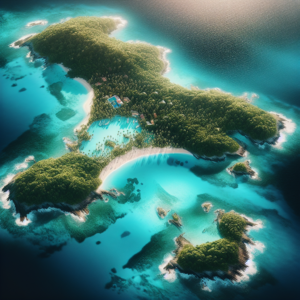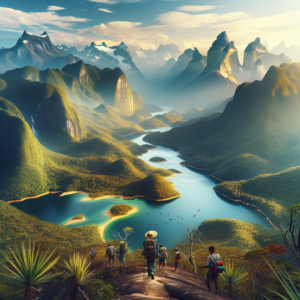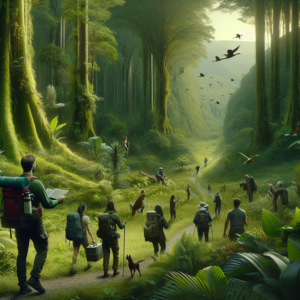The Caribbean is a treasure trove of stunning destinations, but beyond its famous beaches lie secret islands filled with breathtaking landscapes and rich histories. This article delves into these hidden gems, exploring their unique features, cultural backgrounds, and attractions that make them worthwhile for adventurous travelers.
The Allure of the Caribbean’s Hidden Gems
Exploring the hidden islands of the Caribbean invariably leads us to the enchanting contours of Culebra, Saba, and the Grenadines—each a treasure trove of unique allure. **Culebra**, part of Puerto Rico, boasts pristine beaches like Flamenco Beach, often lauded as one of the world’s best. What sets Culebra apart from the more frequented islands is its commitment to environmental conservation, being home to the Culebra National Wildlife Refuge, a sanctuary for sea turtles and various bird species. With its dry tropical climate and coral reefs, the island showcases a rich biodiversity that eagerly invites snorkeling enthusiasts to explore its underwater realms.
Traveling next to **Saba**, the smallest municipality of the Netherlands, visitors are greeted by the highest peak in the kingdom, the dormant volcano Mount Scenery, rising dramatically to 877 meters. Saba’s unspoiled beauty is complemented by its eco-tourism initiatives, aiming to protect its lush rainforests and vibrant marine life. Its captivating hiking trails and charming villages, like The Bottom, provide a glimpse into a culture that marries Dutch colonial history with Caribbean charm. Notably, Saba’s unique tradition of scuba diving offers divers unhindered access to magnificent underwater ecosystems filled with colorful corals and exotic marine life.
Lastly, **the Grenadines**, comprised of 32 islands, paint a picture of tranquility and breathtaking beauty. Islands such as Bequia and Mustique are renowned for their luxurious hideaways yet retain an authentic island vibe. The Grenadines are less commercialized compared to their counterparts like St. Lucia, making them a perfect escape for those seeking authenticity and intimacy with nature. Access to these islands can be achieved via ferry services or small planes, and optimal visiting times are during the dry season from December to April, ensuring travelers experience their finest weather.
These hidden gems collectively offer a compelling allure that extends beyond picturesque landscapes to the rich cultural tapestries, inviting travelers to customize their Caribbean experiences.
A Journey to Secret Islands
Culebra, a small island in Puerto Rico’s Spanish Virgin Islands, is a breathtaking paradise often overlooked by tourists. It boasts stunning beaches, with Flamenco Beach frequently ranking among the world’s best. This 1.5-mile stretch features soft, white sand and azure waters, perfect for swimming and snorkeling. The island’s rich history dates back to Christopher Columbus’s discovery in 1493, but it remains relatively quiet due to its limited accessibility; frequent ferries and small planes are the main transport options. Fascinatingly, Culebra was used as a military training ground by the U.S. Navy until the 1970s, contributing to its secluded charm. Travellers will find a vibrant underwater ecosystem, home to turtles, rays, and colorful fish, best explored between December and June, during the dry season.
Saba, a volcanic island part of the Dutch Caribbean, is only 13 square kilometers yet holds immense allure. Its most prominent feature, Mount Scenery, rises to 2,855 feet, adorned with lush rainforests and rich biodiversity. Saba is often less frequented due to its steep terrain and lack of traditional beaches, appealing instead to ecotourists drawn to hiking and diving. The island is known for its unique culture, characterized by traditional events like the Saba Day celebration. To reach Saba, one can fly directly from St. Maarten or take a ferry, with the dry season from December to April being the ideal time to visit, offering pleasant weather and vibrant local festivals.
The Grenadines, a chain of islands in St. Vincent and the Grenadines, provide a stunning, laid-back alternative to the bustling resorts of the more famous Caribbean destinations. This collection includes islands like Bequia and Mustique, renowned for their breathtaking beaches and exclusive resorts. The islands remain lesser-known due to their remote locations and limited tourism infrastructure. Accessible by inter-island ferries or small planes, the Grenadines offer a tranquil escape characterized by stunning coral reefs and rich marine life, making it a prime spot for snorkeling. The best time to visit is during the dry season from December through May, when the islands are alive with local events, showcasing their rich cultural heritage.
Cultures and Traditions of the Forgotten Isles
The Caribbean is a vibrant tapestry woven from the threads of various cultures, each contributing unique identities and traditions to the lesser-known islands. The indigenous populations, such as the Taino and Arawak, originally inhabited many of these islands, leaving a rich legacy and influencing local customs and languages. These groups faced significant changes post-European colonization, which introduced new cultures, religions, and cuisines that remain integral to Caribbean identity today.
Colonial histories belie the islands’ stories, with Spanish, French, British, and Dutch powers vying for control. This colonial past birthed a melange of languages, reflected in the distinct Creole dialects spoken across the region. The legacy of the African diaspora is also profound, infusing various aspects of Caribbean culture, from music to food, with rhythms and flavors that are unmistakably African.
Festivals on these hidden islands are a celebration of life, often rooted in indigenous practices and colonial history. For example, the vibrant Carnival, celebrated on islands like Dominica and St. Vincent, showcases elaborate costumes, dance, and music—each a testament to resilience and joy. Local cuisine is another cultural anchor, featuring dishes rich in flavor and history. Known for staples like cassava, plantains, and fresh seafood, islands like Culebra serve up traditional meals that feel like a warm embrace.
Crafts and artistry further reflect the islands’ uniqueness. Handcrafted items made from natural materials, such as hats, baskets, and textiles, tell stories of indigenous traditions and contemporary life. Locals often engage in these crafts during markets, providing a glimpse into their daily lives and the continued evolution of their cultures. Eating, celebrating, and creating together enriches the cultural landscape, inviting travelers to immerse themselves fully in these forgotten isles’ identities.
Nature’s Best: Exploring Island Ecosystems
The Caribbean’s hidden islands are treasures of diverse ecosystems offering breathtaking natural attractions. Among these, **coral reefs** are the jewels of the marine environment, often referred to as the “rainforests of the sea.” These vibrant underwater landscapes harbor approximately 25% of all marine species, from colorful fish and mollusks to crustaceans and sponges. Snorkeling and scuba diving in these shallow waters unveil a world of wonder, where visitors can swim among vibrant corals and schools of fish, all while marveling at the delicate balance of life above and below the surface.
Beyond the ocean, lush **rainforests** thrive on many hidden islands, creating rich biodiversity and unique wildlife reserves. These tropical forests are home to exotic birds, such as the endemic parrots that flit between branches, and elusive mammals like iguanas and tree sloths that add charm to the ecosystem. Hiking trails meander through dense canopies, offering outdoor enthusiasts the chance to connect deeply with nature. Guided eco-tours provide a wealth of knowledge about the intricate web of life that exists in these forests, where each plant and creature plays a vital role in maintaining ecological harmony.
Wildlife reserves on these islands serve as sanctuaries for both flora and fauna. These protected areas offer opportunities for birdwatching and nature photography, allowing travelers to document rare species in their natural habitats. Additionally, many islands provide sustainable tourism initiatives that encourage responsible exploration, ensuring that pristine environments remain unspoiled for generations to come.
Whether through snorkeling in vibrant coral gardens, hiking in lush rainforest trails, or participating in eco-tours that nurture a connection with nature, the lesser-known Caribbean islands present an unparalleled gateway to explore the beauty and diversity of island ecosystems. Such experiences embody a deeper appreciation for nature’s secrets, making each visit a magical journey.
Planning Your Adventure to Hidden Paradise
To fully embrace the allure of the hidden paradises in the Caribbean, meticulous planning is essential. Start by pinpointing the islands that capture your interest. For the adventurer, islands like Dominica and Saba are unspoiled treasures, perfect for outdoor pursuits. When it comes to accommodations, options vary widely depending on the island. Embrace local culture by choosing guesthouses or eco-lodges, which not only provide a unique experience but also support the community. For instance, in Dominica, consider the Rosalie Bay Eco Resort, which offers beachfront access and opportunities for hiking and bird-watching.
Local transportation is critical for exploring these remote destinations. While major islands may offer car rentals, many hidden gems are best navigated through ferry services or local taxis. In Saba, for instance, there are no cars, and the island can be explored via walking trails or small eco-friendly vehicles. Another great option is to rent scooters or bicycles for a more immersive experience. Keep in mind that traveling to these islands might involve multiple legs – flights to a larger island followed by a regional airline or ferry.
Creating a flexible itinerary is key for these adventures. Allocate time for relaxation amid stunning natural settings, alongside scheduled activities like snorkeling, hiking, or visiting local markets. For instance, you could plan a full day of hiking in the rainforest one day and then snorkeling the vibrant reefs the next. Encourage spontaneity; chat with locals who often share their favorite spots, enhancing your journey with personal insights.
Engaging with Beyond the mainstream resorts and busy beaches leads to a truly transformative experience. Embrace the spirit of exploration, and you’ll uncover the richness of the hidden Caribbean islands.
Conclusão
The Caribbean’s hidden islands present a remarkable opportunity for travelers seeking authenticity and natural beauty. By venturing off the well-trodden path, visitors can discover breathtaking landscapes, rich cultures, and unforgettable adventures. Embrace the magic of these secret islands for a truly unique Caribbean experience.



